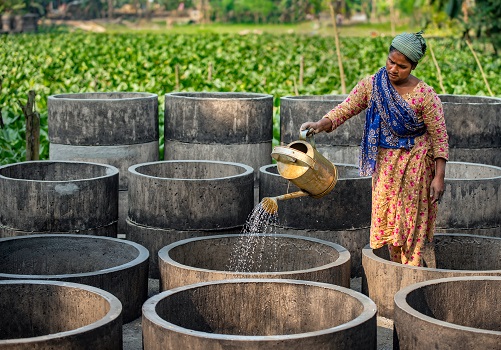On March 22 the United Nations will hold a Water Conference, the first major UN meeting on water, sanitation and hygiene – often grouped together under the acronym WASH – in nearly 50 years.
The meeting will highlight the progress – or lack thereof – toward reaching the UN’s Sustainable Development Goal (SDG) 6, which aims to achieve “universal and equitable access to safe and affordable drinking water” and “adequate and equitable sanitation and hygiene” by 2030. Given it’s been nearly five decades since the UN held its last major convening about this important issue it is high time world leaders find a solution to this problem because it impacts nearly 2 billion people on the planet every single day. And the work to achieve SDG 6 is “alarmingly off track, jeopardizing the entire sustainable development agenda,” according to the UN.
As the SDGs reach their halfway point – they were established in 2015 after the largely successful Millennium Development Goals (MDGs) timed out – spending on WASH needs to be increased four-fold above current levels to achieve SDG 6, according to the concept note for the March conference. Some 25 percent of the global population lack access to safely managed drinking water while 46 percent (3.6 billion people) of people go without safely managed sanitation.
Water vs sanitation
But, to the discerning eye, the concept note, which outlines the key outcomes for the conference, also reveals another alarming fact: global efforts to improve WASH, both at the country level and at the upcoming conference itself, appear severely lopsided. The word “water” appears 114 times in the document while the words “sanitation” and “hygiene” appear seven times and one time respectively.
The fact is, when it comes to financing and political will, efforts to improve sanitation and hygiene have long been overlooked in favor of water within international development. For example, the UN declared 2005-2015 as the International Decade for Action “Water for Life” and announced the world had met its MDG target five years early, halving the proportion of people without access to improved water sources.
At the same time, the UN described sanitation as the “forgotten sister” of WASH saying the issue had been “severely neglected” by international organizations.
And when it came to sanitation, the MDG targets were missed by a longshot. Eight years later, it appears we haven’t learned from past mistakes and history is poised to repeat itself. Today, efforts to reach SDG targets on water are more advanced than sanitation. Some 45 percent of countries being monitored are on track to reach drinking water targets while just 25 percent of countries are on track to reach sanitation targets.
Lumping the two together is short-sighted
But to some frustrated sector experts, who work tirelessly to improve sanitation in low-income countries, the near singular focus on water at the UN conference is symptomatic of the longstanding practice of lumping sanitation and hygiene together with water because they all seek to improve health outcomes such as malnutrition and stunting through behavior change and infrastructure. In its 2020, State of the World’s Sanitation report, UNICEF highlights the lackluster progress on sanitation by pointing out it lacks visibility, investment and specialized skills.
“It suffers from being integrated with water supply, which is typically more appealing to the public and politicians,” says the report. And with the climate crisis leaving much of Africa, Asia, and Latin America at risk of both drought or flooding, the conversation about water has evolved and become more urgent since the SDGs were written, threatening to sideline efforts to improve sanitation even further.
However, given the unique challenges posed by poor sanitation and hygiene, the disparity between the attention they receive compared to water is disappointing. According to the World Health Organization, poor sanitation leads to the deaths of more than 400,000 people every year and is a major cause of tropical diseases, including intestinal worms, schistosomiasis, and trachoma. The pandemic also reminded us about the importance of hygiene and handwashing when it comes to human health and the spread of disease.
Investing in sanitation leads to greater ROI than water
More broadly, we know that quality, accessible sanitation provides dignity and boosts safety, particularly among women and girls. The provision of sanitary and hygienic facilities at schools, including toilet blocks and handwashing stations, also improves school attendance. And a 2012 WHO study found that for every US$1 invested in sanitation, there was a return of US$5.50 in lower health costs, more productivity and fewer premature deaths. Return on investment for interventions targeting water are far lower.
Moreover, sanitation, in particular, requires much greater attention, not only for the enormous challenge it is now, but because of the looming crisis climate change presents. Devastating floods, such as those that swept through northeast Bangladesh last year, threaten sanitation infrastructure in low-lying and coastal areas worldwide, with the potential to release enormous amounts of untreated waste into the environment, causing further contamination. Recent strides taken to improve sanitation in Bangladesh, which now has 64 percent basic service coverage, could be reversed by increased incidences of flooding. The same is true in Cambodia, where open defecation has been dramatically reduced across much of the countryside.
It’s time to take meaningful action on sanitation
However, climate change poses a threat to existing infrastructure, from latrines to road systems, which rural communities depend on. Yet, climate financing, which averages $575 billion a year, has largely overlooked sanitation as public spending on WASH has instead favored large urban infrastructure projects, which do not always benefit communities most vulnerable to climate change. Meanwhile, basic water and sanitation projects, such as increasing access to non-sewered sanitation in rural areas, receive just 8 percent of the funds being delivered, with a negligible share going to sanitation.
To address the imbalance between water and sanitation, world leaders should seize the opportunity presented by this month’s gathering at UN headquarters in New York and finally move beyond the rhetoric and take meaningful action on sanitation. While latrines will never have the same panache or news value as a crystal clear glass of water, life without them can be just as deadly as a contaminated well or borehole. Funding and attention should, therefore, flow accordingly. If not, in the post-SDG agenda, the question is begged: should sanitation go it alone rather than lurk in the shadows of water to finally get the attention it deserves?
Sarah Custer-Lalanne and Simon Crittle are respective directors of global WASH and global communications for International Development Enterprises (iDE).



